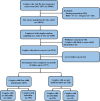Incidence and risk factors of infertility among couples who desire a first and second child in Shanghai, China: a facility-based prospective cohort study
- PMID: 35804377
- PMCID: PMC9270756
- DOI: 10.1186/s12978-022-01459-x
Incidence and risk factors of infertility among couples who desire a first and second child in Shanghai, China: a facility-based prospective cohort study
Abstract
Background: With the implementation of the two-child policy in China, more couples have expressed the desire to have another child. We conducted this study to evaluate the incidence of infertility and risk factors in couples intending to have a first and second child.
Methods: From 2013 to 2017, a prospective cohort study was conducted at the pre-pregnancy center of the International Peace Maternal and Child Health Hospital. The participants were selected by screening and random sampling couples who came to the pre-pregnancy center. Data regarding patient sociodemographic characteristics, reproductive and gynecological history, male disease history, and laboratory and imaging examination results were collected. Couples were followed up every 3 months until pregnancy or for 12 months, whichever came first. Multi-factor logistic regression was used to analyze risk factors for infertility. Adjusted odds ratios (aORs) and corresponding 95% confidence intervals (CIs) were calculated and adjusted for potential confounding factors.
Results: The overall infertility incidence was 16.95% (369/2177). The infertility incidence of "first child intention" and "second child intention" was 19.30% (355/1839) and 4.14% (14/338), respectively. This study found great differences in both infertility rate (P < 0.001) and risk factors between the two groups. Risk factors for "first child intention" infertility included advanced age (> 35 years) (aOR = 1.70, 95% CI 1.27-2.28), abnormal body mass index (BMI) (aOR = 1.58, 95% CI 1.31-6.26), longer menstrual periods (aOR = 4.47, 95% CI 2.25-8.88), endometrial polyps (aOR = 2.52, 95% CI 1.28-4.97), polycystic ovarian syndrome (PCOS) (aOR = 6.72, 95% CI 1.79-7.39), salpingostomy (aOR = 3.44, 95% CI 1.68-7.07), and history of mycoplasma (aOR = 1.54, 95% CI 1.09-2.40). However, in the "second child intention" group, clinical risk factors slightly differed and included leiomyoma (aOR = 5.60, 95% CI 1.06-29.76), and higher age (> 40 years) (aOR = 7.36, 95% CI 1.01-53.84).
Conclusion: The overall infertility rate in Shanghai is similar to that of other large cities in China. Marriage at advanced ages has become increasingly common. As such, the government must consider subsidies to encourage childbirth at childbearing ages, which can improve fertility levels.
Keywords: Epidemiology; First child intention; Incidence; Infertility; Risk factor; Second child intention.
Plain language summary
Infertility is defined as pregnancy failure after at least 12 months of regular unprotected sexual intercourse. Few researchers have investigated the infertility rate in Shanghai in the past 15 years, and little attention has been paid to the infertility of couples hoping to have a second child. We conducted a prospective cohort study in Shanghai to evaluate infertility incidence and risk factors in couples intending to have a first or second child. The investigators administered a questionnaire survey to the participants and followed them for 1 year. Finally, 1839 couples intending to have a first child and 338 couples intending to have a second child were included in this study. The overall infertility incidence was 16.95% (369/2177). However, the infertility incidence of the “first child intention” and “second child intention” groups was 19.30% (355/1839) and 4.14% (14/338), respectively. Risk factors for “first child intention” infertility included advanced age (> 35 years), abnormal body mass index (BMI), longer menstrual periods, endometrial polyps, polycystic ovarian syndrome (PCOS), salpingostomy, and history of mycoplasma; in the “second child intention” group, clinical risk factors slightly differed and included leiomyoma and advanced age (> 40 years). Since studies have shown large differences in infertility risk factors between the two groups, early and targeted intervention for couples in different high-risk groups can help reduce infertility.
© 2022. The Author(s).
Conflict of interest statement
The authors declare there is no conflict of interest.
Figures



Similar articles
-
Fertility Intention and Related Factors for Having a Second or Third Child Among Childbearing Couples in Shanghai, China.Front Public Health. 2022 Jun 9;10:879672. doi: 10.3389/fpubh.2022.879672. eCollection 2022. Front Public Health. 2022. PMID: 35757654 Free PMC article.
-
Epidemiology of infertility in China: a population-based study.BJOG. 2018 Mar;125(4):432-441. doi: 10.1111/1471-0528.14966. Epub 2017 Dec 28. BJOG. 2018. PMID: 29030908
-
BMI in childhood and adolescence is associated with impaired reproductive function-a population-based cohort study from birth to age 50 years.Hum Reprod. 2021 Oct 18;36(11):2948-2961. doi: 10.1093/humrep/deab164. Hum Reprod. 2021. PMID: 34364312 Free PMC article.
-
Infertility and assisted reproduction in Denmark. Epidemiology and psychosocial consequences.Dan Med Bull. 2006 Nov;53(4):390-417. Dan Med Bull. 2006. PMID: 17150146 Review.
-
Dropout of infertility treatments and related factors among infertile couples.Reprod Health. 2020 Dec 2;17(1):192. doi: 10.1186/s12978-020-01048-w. Reprod Health. 2020. PMID: 33267894 Free PMC article.
Cited by
-
Exploring depressive symptoms and coping strategies in Chinese women facing infertility: A cross-sectional observational study.Medicine (Baltimore). 2024 Jul 26;103(30):e39069. doi: 10.1097/MD.0000000000039069. Medicine (Baltimore). 2024. PMID: 39058823 Free PMC article.
-
The effect of gradually lifting the two-child policy on demographic changes in China.Health Policy Plan. 2024 Apr 10;39(4):363-371. doi: 10.1093/heapol/czae008. Health Policy Plan. 2024. PMID: 38334690 Free PMC article.
-
The association of CGG repeat length and AGG interruption patterns on FMR1 alleles with female infertility.Front Endocrinol (Lausanne). 2025 Jun 17;16:1609471. doi: 10.3389/fendo.2025.1609471. eCollection 2025. Front Endocrinol (Lausanne). 2025. PMID: 40600017 Free PMC article.
-
Association between combined healthy lifestyles and infertility: a cross-sectional study in US reproductive-aged women.BMC Public Health. 2025 Jan 14;25(1):153. doi: 10.1186/s12889-025-21395-2. BMC Public Health. 2025. PMID: 39815248 Free PMC article.
-
Predictors and incidence of depression and anxiety in women undergoing infertility treatment: A cross-sectional study.PLoS One. 2023 Apr 13;18(4):e0284414. doi: 10.1371/journal.pone.0284414. eCollection 2023. PLoS One. 2023. PMID: 37053254 Free PMC article.
References
MeSH terms
Grants and funding
LinkOut - more resources
Full Text Sources
Medical
Research Materials
Miscellaneous

